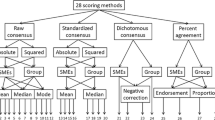Abstract
Using a broad-based measure of normal personality, we tested the hypothesis that the trait “conscientiousness” is the best single predictor of scores on two well-researched integrity tests. Data from 180 traditional and nontraditional college students provided clear support for this hypothesis, but also indicated that a number of traits other than conscientiousness were likely to be related to integrity test scores. Scores on all six of the primary scales, and 33 of the 45 homogeneous item clusters (HICs) of the Hogan Personality Inventory were related to scores on the PDI Employment Inventory and/or the Personnel Selection Inventory. Personality variables were better predictors of scores on the PDI Employment inventory, which is a veiled-purpose (also referred to as “personality based”) test, than of scores on the Personnel Selection Inventory, which measures honesty-related attitudes and includes items calling for direct admissions of misdeeds.
Similar content being viewed by others
References
Ash, P. (1991).The construct of employee theft proneness. Park Ridge, IL: SRA/London House.
Azjen, I. & Fishbein, M. (1977). Attitude-behavior relations: A theoretical analysis and review of empirical research.Psychological Bulletin, 84, 888–918.
Barrick, M.R. & Mount, M.K. (1991). The Big Five personality dimensions and job performance: A meta-analysis.Personnel Psychology, 44, 1–26.
Collins, J.M. & Schmidt, F.L. (1992).Personality, integrity and white collar crime. Presented as Annual Conference of Society for Industrial and Organizational Psychology, Montreal.
Digman, J.M. (1990). Personality structure: Emergence of the five-factor model.Annual Review of Psychology, 41, 417–440.
Hogan, R.T. (1986).Manual for the Hogan Personality Inventory. Minneapolis: National Computer Systems.
Hogan, J. & Hogan, R. (1989). How to measure employee reliability.Journal of Applied Psychology, 74, 273–279.
Jones, J.W. & Terris, W. (1983). Personality correlates of theft and drug abuse among job applicants.Proceedings of the Third International Conference on the 16PF Test, 85–94.
Korchin, S. (1987). Personality correlates of a measure of honesty.Journal of Business and Psychology, 1, 236–247.
Logan, T.G., Koettel, R.C. & Moore, R.W. (1986). Personality correlates of a test of honesty.Psychological Reports, 59, 1015–1018.
McCrea, R.R. & Costa, P.T., Jr. (1985). Updating Norman's “adequate taxonomy”: Intelligence and personality dimensions in natural language and questionnaires.Journal of Personality and Social Psychology, 49, 710–721.
McCrea, R.R. & Costa, P.T., Jr. (1986). Clinical assessment can benefit from recent advances in personality psychology.American Psychologist, 51, 1001–1002.
McCrea, R.R. & Costa, P.T., Jr. (1987). Validation of the five-factor model of personality across instruments and observers.Journal of Personality and Social Psychology, 52, 81–90.
Murphy, K.R. (1993).Honesty in the workplace. Pacific Grove, CA: Brooks/Cole.
O'Bannon, M.R., Goldinger, L.A. & Appleby, G.S. (1989).Honesty and integrity testing: A practical guide. Atlanta, GA: Applied Information Resources.
Ones, D.S., Viswesvaran, C., & Schmidt, F.L. (In press). Integrity test validities: Meta-analytic tests of moderator hypotheses.Journal of Applied Psychology.
Rafilson, F.M. (1988). Development of a standardized measure to predict employee productivity.Journal of Business and Psychology, 3, 199–213.
Sackett, P.R., Burris, L.R. & Callahan, C. (1989). Integrity testing for personnel selection: An update.Personnel Psychology, 42, 491–592.
Sackett, P.R. & Harris, M.M. (1984). Honesty testing for personnel selection: A review and critique.Personnel Psychology, 37, 221–245.
U. S. Congress, Office of Technology Assessment. (1990).The use of integrity tests for preemployment screening (OTA-SET 442). Washington, DC: U. S. Government Printing Office.
Woolley, R.M. & Hakstian, A.R. (In press). An examination of the construct validity of personality-based and overt measures of integrity.Educational and Psychological Measurement.
Author information
Authors and Affiliations
Additional information
We are grateful for the assistance and cooperation of London House Inc., Personnel Decisions Inc., and Hogan Assessment Systems, Inc., and especially to Scott Martin, George Paajanen, and Joyce Hogan.
Rights and permissions
About this article
Cite this article
Murphy, K.R., Lee, S.L. Personality variables related to integrity test scores: The role of conscientiousness. J Bus Psychol 8, 413–424 (1994). https://doi.org/10.1007/BF02230957
Issue Date:
DOI: https://doi.org/10.1007/BF02230957



